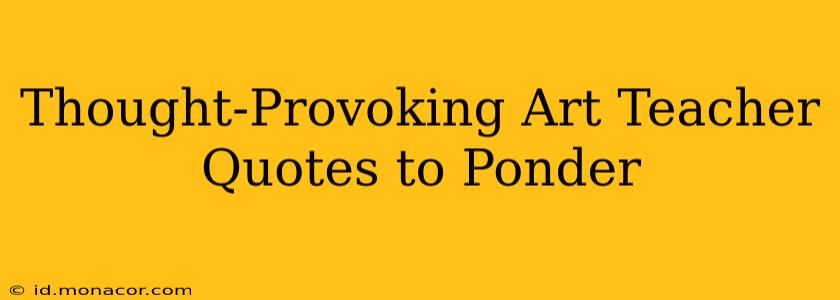Art teachers, with their unique blend of creativity, pedagogy, and passion, often impart wisdom that extends far beyond the canvas or clay. Their quotes, whether intentionally profound or subtly insightful, can spark introspection and inspire a deeper understanding of art, life, and ourselves. This collection explores some thought-provoking quotes from art teachers, delving into their meaning and relevance for both artists and non-artists alike.
What Makes a Great Art Teacher?
This question lies at the heart of many discussions about effective art education. A great art teacher isn't just someone skilled in their craft; they are a facilitator of creative exploration, a mentor guiding students through the complexities of self-expression, and a champion of individual artistic voices. Their ability to inspire, challenge, and nurture creativity defines their impact.
"Art is not what you see, but what you make others see." – Edgar Degas
This famous quote, while not directly from an art teacher, encapsulates a core tenet of art education. It highlights the collaborative and communicative nature of art. A great art teacher encourages students not just to create, but to consider the impact and interpretation of their work by others. It's about fostering empathy and understanding through artistic expression.
"The purpose of art is washing the dust of daily life off our souls." – Pablo Picasso
Picasso's words speak to the therapeutic and transformative power of art. Art teachers often use this principle to help students process emotions, explore their identities, and find solace in creative expression. The act of creating art becomes a form of self-care, a release of pent-up energy and a pathway to emotional healing.
What are the benefits of art education?
Art education offers a plethora of benefits extending far beyond artistic skill development. It cultivates problem-solving abilities, critical thinking, and self-confidence. Students learn to embrace failure as a stepping stone to success and develop resilience in the face of challenges. The process of creating art fosters self-discovery and strengthens emotional intelligence.
"Every child is an artist. The problem is how to remain an artist once we grow up." – Pablo Picasso
This poignant observation underscores the importance of nurturing creativity from a young age. Art teachers play a crucial role in fostering this creativity, ensuring that the inherent artistic spirit of children isn't stifled as they mature. The quote challenges us to reflect on how societal pressures and expectations might hinder our creative potential.
How do I encourage my child's creativity?
Encouraging a child's creativity involves providing a supportive and stimulating environment. This includes access to art supplies, opportunities for open-ended exploration, and freedom from judgment. Positive reinforcement and celebrating the process of creation, rather than just the final product, are crucial elements. Parents can also engage in creative activities alongside their children, modeling a lifelong love of art.
"Art washes away from the soul the dust of everyday life." – Pablo Picasso (Slight variation on a previous quote)
This emphasizes the cleansing and rejuvenating power of artistic creation. For art teachers, this translates into creating a classroom environment where students feel safe to experiment, take risks, and express themselves authentically, without fear of judgment. The art-making process becomes a form of catharsis and emotional release.
How can art therapy help with stress and anxiety?
Art therapy utilizes the creative process to address mental health concerns. It provides a non-verbal outlet for emotional expression, allowing individuals to explore their thoughts and feelings in a safe and supportive environment. The focus is on the therapeutic process of art-making, not necessarily on creating a finished artwork.
"The aim of art is to represent not the outward appearance of things, but their inward significance." – Aristotle
While not a direct quote from an art teacher, Aristotle's words highlight the deeper meaning and purpose often explored in art classes. Art teachers encourage students to move beyond superficial representation and delve into the symbolic, emotional, and conceptual aspects of their work. It’s about understanding the why behind the what.
In conclusion, the wisdom shared by art teachers, whether through direct quotes or embodied in their teaching philosophy, offers valuable insights into the transformative power of art. These quotes serve as a reminder of the profound impact art can have on our lives, enriching our understanding of ourselves and the world around us. The role of the art teacher in fostering this understanding is paramount.

